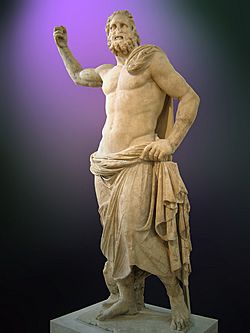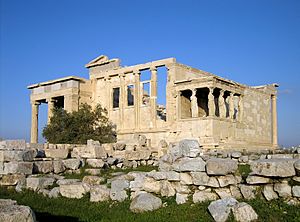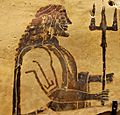Poseidon facts for kids
Quick facts for kids Poseidon |
|
|---|---|
| God of the sea, storms, earthquakes, horses | |

Poseidon from Milos, 2nd century BC (National Archaeological Museum of Athens)
|
|
| Abode | Mount Olympus, or the Sea |
| Symbol | Trident, fish, dolphin, horse, bull |
| Personal information | |
| Consort | Amphitrite, Aphrodite, Demeter, various others |
| Children | Theseus Triton Polyphemus Orion Belus Agenor Neleus Atlas (the first king of Atlantis) Pegasus Chrysaor |
| Parents | Cronus and Rhea |
| Siblings | Hades, Demeter, Hestia, Hera, Zeus, Chiron |
| Roman equivalent | Neptune |
In Greek mythology, Poseidon was the god of the sea and one of the Twelve Olympians. He is the brother of Zeus, Hades, Hestia, Demeter and Hera. He is the second most powerful god after Zeus. His home is Mount Olympus and all the water on earth. He is the god of the sea and earthquakes, the cyclops and of horses.
Poseidon became lord of the sea when, following the overthrow of his father Cronus, the world was divided by lot among Cronus' three sons; Zeus was given the sky, Hades the underworld, and Poseidon the sea, with the Earth and Mount Olympus belonging to all three.
Poseidon also was said to have created horses. It is believed that when riding his chariot (that was pulled by hippocampi) the sea foam turned into horses.
Contents
Worship
Poseidon was a major civic god of several cities: in Athens, he was second only to Athena in importance, while in Corinth and many cities of Magna Graecia he was the chief god.
Poseidon was seen as creating new islands and offering calm seas. When offended or ignored, he supposedly struck the ground with his trident and caused chaotic springs, earthquakes, drownings and shipwrecks. This earned him the nickname the "Earth Shaker". Sailors prayed to Poseidon for a safe voyage.
Poseidon is still worshipped today in modern Hellenic religion, among other Greek gods. The worship of Greek gods has been recognized by the Greek government since 2017.
Mythology
In some stories, Poseidon is believed to have been swallowed by his father Cronos. Later when Zeus was saved by Rhea, Zeus tricked Kronos into regurgitating all his siblings.
In other versions, his mother Rhea saves him by feeding her husband a small horse wrapped in a blanket.
Foundation of Athens
Athena became the patron goddess of the city of Athens after a competition with Poseidon. They agreed that each would give the Athenians one gift and the Athenians would choose whichever gift they preferred. Poseidon struck the ground with his trident and a spring sprang up; the water was salty and not very useful, whereas Athena offered them an olive tree.
The Athenians or their king, Cecrops, accepted the olive tree and along with it Athena as their patron, for the olive tree brought wood, oil and food. After the fight, infuriated at his loss, Poseidon sent a monstrous flood to the Attic Plain, to punish the Athenians for not choosing him.
Consorts and children
He was married to Amphitrite, a sea goddess, with whom he had a son, Triton, a merman.
Poseidon was the father of many heroes. He is thought to have fathered the famed Theseus.
A mortal woman named Cleito once lived on an isolated island; Poseidon fell in love with the human mortal and created a dwelling sanctuary at the top of a hill near the middle of the island and surrounded the dwelling with rings of water and land to protect her. She gave birth to five sets of twin boys; the firstborn, Atlas, became the first ruler of Atlantis.
Not all of Poseidon's children were human. His other children include Polyphemus (the Cyclops) and, finally, Alebion and Bergion and Otos and Ephialtae (the giants).
Poseidon was once in love with Medusa, who was a beautiful woman. When Athena discovered them in her temple, she turned Medusa into a Gorgon-a terrible monster with snake hair and a stare that turned people into stone. Her two sisters were also punished, although neither of them were as powerful nor gruesome as Medusa.
In literature and art
In Greek art, Poseidon rides a chariot that was pulled by a hippocampus or by horses that could ride on the sea. He was associated with dolphins and three-pronged fish spears (tridents). He lived in a palace on the ocean floor, made of coral and gems.
Related pages
- Neptune – Roman mythology version of Poseidon
Images for kids
-
The Dispute of Minerva and Neptune by René-Antoine Houasse (circa 1689 or 1706)
-
Poseidon holding a trident. Corinthian plaque, 550-525 BC. From Penteskouphia.
-
Poseidon on an Attic kalyx krater (detail), first half of the 5th century BC.
-
Poseidon statue in Gothenburg, Sweden.
-
The Neptunbrunnen fountain in Berlin
-
Poseidon sculpture in Copenhagen, Denmark
See also
 In Spanish: Poseidón para niños
In Spanish: Poseidón para niños














